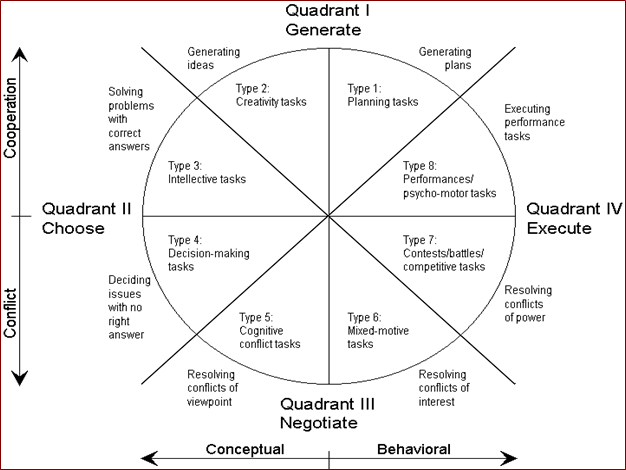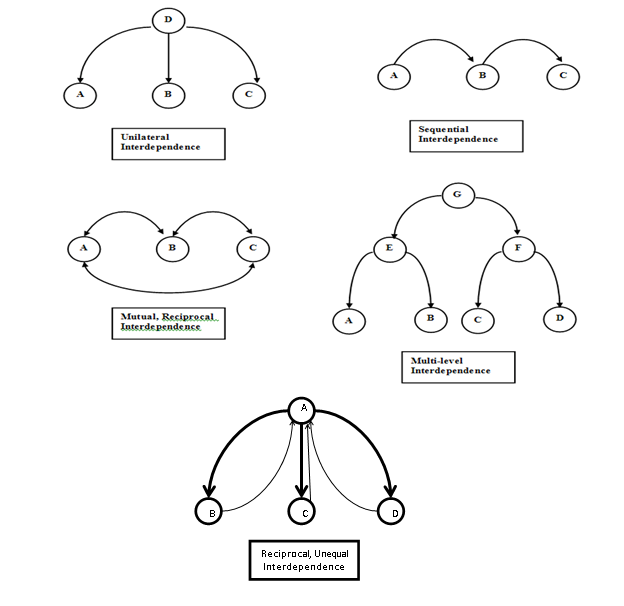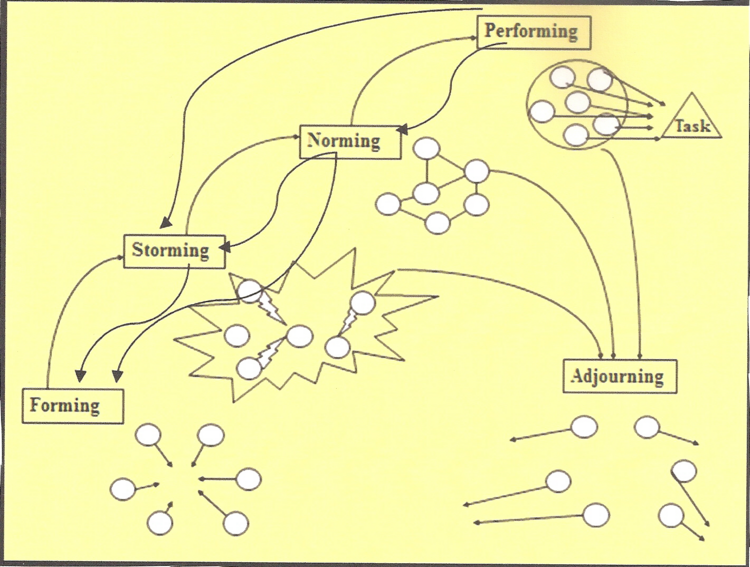Difference between revisions of "Team Dynamics"
(→Stage) |
(→Stage) |
||
| Line 43: | Line 43: | ||
| − | [[File: | + | [[File:Stages_of_Group_Development.png|center|750px|Stages of Group Development]] |
==Practical Considerations== | ==Practical Considerations== | ||
Revision as of 23:05, 31 July 2011
Introduction
Teams are special type of groups. Teams are “an organized, task-focused group (Forsyth, 2010, p. 352).” Groups are “Two or more individuals who are connected by and within social relationships (Forsyth, 2010, p. 3).”
An understanding of Team dynamics is essential to enable teams to perform successful systems engineering. The interplay of the behaviors of humans in groups is varied, changing, and inescapable. Nevertheless, study of these behaviors has yielded valuable insight and knowledge on the dynamics of individuals within groups. The awareness and application of this information is crucial to facilitate teams performing work and accomplishing their goals.
The study of group dynamics has been the province of psychology and later sociology. The importance of group dynamics in teams has led other disciplines such as business management to study team dynamics.
History
The origins of the study of group dynamics began with Gustave Le Bon. Le Bon wrote La psychologie des foules, 1895 and its English translation The Crowd: A Study of the Popular Mind, 1896. Sigmund Freud wrote Group Psychology and the Analysis of the Ego 1922 in and analysis and response to Le Bon work. Kurt Lewin is acknowledged as the "founder of social psychology" who coined the term “group dynamics.” He founded the Research Center for Group Dynamics at the Massachusetts Institute of Technology in 1945, relocated in 1948 to the University of Michigan. Wilfred Bion studied group dynamics from a psychoanalytical perspective. He help found the Tavistock Institute of Human Relations in 1947. In that same year, both the Research Center for Group Dynamics and the Tavistock Institute of Human Relations founded the journal Human Relations. The study group dynamics is now worldwide, active, well established as shown by the number of journals related to Organizational Psychology and Group Behavior here http://www.socialpsychology.org/journals.htm and here http://www.socialpsychology.org/io.htm#journals.
Nature of Groups
Groups are endemic to human existence and experience. They cannot be avoided. Consequentially, an informed understanding of the nature of groups is very useful to enabling teams to perform systems engineering. Research of groups revealed the nature of a group can be described by interaction, goals, interdependence, structure, unity, and stage (Forsyth, 2010, pp. 5-10).
Interaction
Communications both verbal and non-verbal between members within group produce constantly changing and varied interactions. Groups are more than just the sum of its members. Interactions create behaviors and results that were not present in the collection of its members. Interactions can be placed into two categories (1) socio-emotional interactions and (2) task interactions (Bales 1950, 1999).
Goals
All groups exist for at least one goal if not many goals. The group’s goals provide the purpose for the group’s activities. The circumplex model of group tasks characterizes and categorizes the activities of groups (McGrath, 1984).
Interdependence
Interdependence is “the state of being dependent to some degree on other people, as when one’s outcomes, actions, thoughts, feelings, and experiences are determined in whole or in part by others (Forsyth, 2010, p. 8).” Interdependence can be categorized in five types (1) mutual, reciprocal, (2) unilateral, (3) reciprocal, unequal, (4), serial, and (5) multi-level as shown below. (Forsyth, 2010, p. 8, Fig. 1.3).
Structure
Structure is the organization and patterned behaviors of a group. The structure can be deliberately devised and emergently observed. Most groups have both. It is evinced in the roles and norms of the group. “The roles of leader and follower are fundamental ones in many groups, but other roles — information seeker, information giver, elaborator, procedural technician, encourager, compromiser, harmonizer — may emerge in any group (Benne & Sheats, 1948) (Forsyth, 2010, p. 9).” Norms are the rules that govern the actions of group members. The rules can be both formal and informal.
Cohesion
The “interpersonal forces that bind the members together in a single unit with boundaries that mark who is in the group and who is outside of it” constitute a group’s cohesion. It is an essential quality of group. A group cannot exist without cohesion (Dion, 2000).
Stage
Groups exhibit stages of development. Being comprised of living people, it intuitively is not surprising that groups collectively demonstrate the dynamics and growth of the individuals that form the members of the group. The most well-known and wide-spread model of the stages of group development was developed by Bruce Tuckman. The initial model identified the sequence of group development as (1) Forming, (2) Storming, (3) Norming, and (4) Performing (Tuckman, 1965). He later added a final adjourning to the model (Tuckman & Jensen, 1977). While Tuckman’s model is sequential others have shown that groups actually may recursively and iterate through the different stages as shown in the figure below (Forsyth, 2010, p.20, Modified Figure 1.5).
Practical Considerations
The dynamics associated with creating, nurturing, leading, a performing team that will successfully achieve team goals is important and a challenge. Although psychologists and sociologists have performed and continue to perform research to understand team dynamics, the profession of business management has sought to develop practical guidance to utilize and apply this knowledge to foster high performing teams. Accordingly, this profession has focused its contribution to the field of team dynamics by publishing practical guidebooks (see additional readings) to analyze the problems and focus on developing solutions to the problems of teams. Additionally, there are many world-wide consultancy firms that assist with the application of practical knowledge on team dynamics to organization. Successful systems engineering teams would do well not to ignore, but take advantage of this knowledge.
References
Please make sure all references are listed alphabetically and are formatted according to the Chicago Manual of Style (15th ed). See the BKCASE Reference Guidance for additional information.
Citations
Bales, R.F. (1950) Interaction process analysis: A method for the study of small groups. Reading, MA: Addison-Wesley
Bales, R.F. (1999) Social interaction systems: Theory and measurement. New Brunswick, NJ: Transaction.
Benne, K.D. & Sheats, P. (1948). Functional roles of group members. Journal of Social Issues, 4 41-49.
Dion, K.L. (2000). Group cohesion: From “field of forces” to multidimensional construct. Group Dynamics: Theory, Research, and Practice, 4, 7-26.
Forsth, D.R. (2010) Group Dynamics (5th ed.) Belmont, CA: Wadsworth, Cengage Learning.
McGrath, J.E. (1984) Groups: Interaction and performance. Upper Saddle River, NJ: Prentice Hall.
Tuckman, Bruce W. (1965). Developmental sequence in small groups. Psychological Bulletin, 63, 384-399.
Tuckman, Bruce W., & Jensen, Mary Ann C. (1977). Stages of small group development revisited. Group and Organizational Studies, 2, 419- 427.
Primary References
Forsth, D.R. (2010) Group Dynamics (5th ed.) Belmont, CA: Wadsworth, Cengage Learning.
Additional References
Scholtes, P.R., Joiner, B.L., & Streibel, B.J. (2003) The Team Handbook (3rd ed.) Edison, NJ: Oriel Inc.
Larson, C.E. & LaFaso, F.M.J. (1989) Teamwork: what must go right, what can go wrong. Newbury Park, CA: Sage Publications, Inc.
Lencioni, P. (2002) The Five Dysfunctions of a Team: A Leadership Fable. San Francisco, CA: Jossey-Bass.
Lencioni, P. (2005) Overcoming the Five Dysfunctions of a Team. San Francisco, CA: Jossey-Bass.


